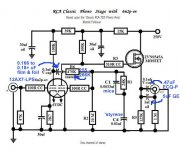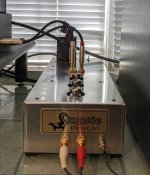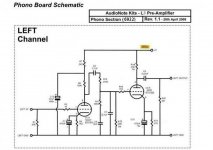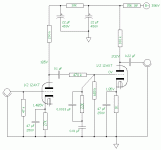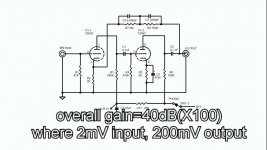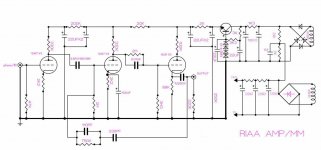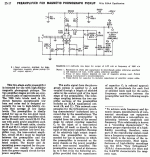Good and bad examples of both technologies are easily discovered.
How about a hybrid? The tweaked RCA setup I'm associated with deals with the downstream drive and bass extension weaknesses of the original. Some carts. and SUTs interact adversely with the high Miller capacitance of the 12AX7/ECC83 and a different 1st gain block type is the solution to that problem.
How about a hybrid? The tweaked RCA setup I'm associated with deals with the downstream drive and bass extension weaknesses of the original. Some carts. and SUTs interact adversely with the high Miller capacitance of the 12AX7/ECC83 and a different 1st gain block type is the solution to that problem.
Attachments
Ok since I have both my 6l6 and el34 tube amps running were I want them I'm not on the hunt for a simple but good sounding Phono Preamp . So is it best to run a Phono pre amp tube or soild state with my tube amps???
There are very good versions of both, depends on your budget. In my experience, and inexpensive tube pre beats an inexpensive SS pre. I prefer tubes and have been looking at the Tubes4HiFi offerings.
Those EAR834 clones are hard to beat. I built one from one of those $50 board kits off ebay, used a hammond PT and choke, and it sounds REALLY good. Especially the bass is so fluid. I've compared it to $700+ SS phono stages and it holds it own quite well.
I'm starting a youtube series about building a V2, focused on using higher end passives and redoing the layout to try to get rid of a tine bit of hum it has.
All tube Phono Stage, Moving Magnet Pre-amp - YouTube
I'm starting a youtube series about building a V2, focused on using higher end passives and redoing the layout to try to get rid of a tine bit of hum it has.
All tube Phono Stage, Moving Magnet Pre-amp - YouTube
Attachments
Good and bad examples of both technologies are easily discovered.
How about a hybrid? The tweaked RCA setup I'm associated with deals with the downstream drive and bass extension weaknesses of the original. Some carts. and SUTs interact adversely with the high Miller capacitance of the 12AX7/ECC83 and a different 1st gain block type is the solution to that problem.
Adding a feedback or a bootstrap in the first stage helps a lot and it was the norm back in the 70's
Tubes are only better at dealing with dust.A perfectly clean record will be played much better by a good quality op-amp of todays, but that lasts just a few minutes until dust take its regular place in the grooves...Having built tubes, hybrid and IC preamps i'd go with hybrid once again, but pure tube preamps are good enough if good quality.Not all of them are equal though.Me and a friend of mine discovered that regular bipolar input discrete preamps(3 tranistor stages) found in most receivers in the 70's are better at dealing with dust than much more advanced fet input, cascode, ltp, differential or any other modern topology.
Last edited:
The first two are dead-loss designs, hardly ideal but certainly good enough for phono, with its inherent limitations. The third is a more classic variation on this possibly most interesting audio design issue, the 12AX7 two stage phono equalizer. The feedback network is way, way wrong for RIAA and the midband gain is 34dB instead of the stated 40dB, and there's DC on the output terminals, but.
The Holy Grail Quest that makes the 12AX7 phono equalizer forever interesting is that it's tantalizingly just out of reach. Adding a third stage, a follower at the end, resolves all problems and gives great design latitude, but that would be cheating.
My personal favorite is a first stage with battery bias, cathode to ground, and a second stage of anode follower with RIAA in the feedback.
But today, for a new design, why limit ourselves? Beautiful little Russian pentodes like the 6Zh9Pi and 6Zh11Pi are still around. Even Mullard E180F, American and Japanese 6JC6, etc. are cheap enough to sort for 1/f noise and live happily ever after.
All good fortune,
Chris
The Holy Grail Quest that makes the 12AX7 phono equalizer forever interesting is that it's tantalizingly just out of reach. Adding a third stage, a follower at the end, resolves all problems and gives great design latitude, but that would be cheating.
My personal favorite is a first stage with battery bias, cathode to ground, and a second stage of anode follower with RIAA in the feedback.
But today, for a new design, why limit ourselves? Beautiful little Russian pentodes like the 6Zh9Pi and 6Zh11Pi are still around. Even Mullard E180F, American and Japanese 6JC6, etc. are cheap enough to sort for 1/f noise and live happily ever after.
All good fortune,
Chris
BTW, here is the schematic of the unit I build as supplied by the kit vendor. Looks like they cheated 
Also, I ended up using 7025 tubes as regular 12AX7 tubes were too noisy in this application. The new production EH sounded good, but I ended up with a mix of NOS: 2 RCA, with a Motorola in the first position.
Also, I ended up using 7025 tubes as regular 12AX7 tubes were too noisy in this application. The new production EH sounded good, but I ended up with a mix of NOS: 2 RCA, with a Motorola in the first position.
Attachments
I've built this and it works well. RJM Audio - Tube passive phono preamplifier
I built a variant of Allen Wrights SVP. Except in my current version I use 5842s in the phono and 5687 in the linestage. ( you need the gain and drive for the phono stage). It is a hybrid cascade on the first stage, and can do MC without SUT.
Never underestimate the need for a good power supply. I used a variant of the salad sshv. (Well I don’t use 1, I use a few more) Designed my own pcb to make use of heatsinks.
And don’t forget He spent a fair amount of his life in Straya!
Never underestimate the need for a good power supply. I used a variant of the salad sshv. (Well I don’t use 1, I use a few more) Designed my own pcb to make use of heatsinks.
And don’t forget He spent a fair amount of his life in Straya!
FWIW, I favor culled, phono grade, Sovtek 12AX7LPS specimens from Jim McShane. The 'LPS is a genuine 7025 equivalent whose heater is spiral wound and hum bucking.
It is possible to obtain acceptable residual hum levels with AC heating, using tubes built with hum bucking heaters (7025/6EU7), but (IMO) only a masochist takes that path.
Back at the end of the 1940s, when RCA worked up the "classic" passive EQ setup, the SS stuff we take for granted that makes DC heating easy was not available. RCA called for 7025s, as the struggle with AC heating was the only practical option available.
It is possible to obtain acceptable residual hum levels with AC heating, using tubes built with hum bucking heaters (7025/6EU7), but (IMO) only a masochist takes that path.
Back at the end of the 1940s, when RCA worked up the "classic" passive EQ setup, the SS stuff we take for granted that makes DC heating easy was not available. RCA called for 7025s, as the struggle with AC heating was the only practical option available.
Attachments
Good and bad examples of both technologies are easily discovered.
How about a hybrid? The tweaked RCA setup I'm associated with deals with the downstream drive and bass extension weaknesses of the original. Some carts. and SUTs interact adversely with the high Miller capacitance of the 12AX7/ECC83 and a different 1st gain block type is the solution to that problem.
Eli,
Did you also designed a PCB from this circuit?
If you're looking at 12AX7 RIAA preamps and you want PCBs, maybe these would work for you?
The Valve Wizard
There's also a capacitance-multiplier HV and regulated LV power supply PCB that goes with those.
Regulated Power Supply
You can get hum levels low enough with a passive (resistance-capacitance) smoothed HV supply, but Eli's right that only a masochist would attempt an RIAA preamp with AC heater supply.
--
The Valve Wizard
There's also a capacitance-multiplier HV and regulated LV power supply PCB that goes with those.
Regulated Power Supply
You can get hum levels low enough with a passive (resistance-capacitance) smoothed HV supply, but Eli's right that only a masochist would attempt an RIAA preamp with AC heater supply.
--
Last edited:
How about this design? You can find it here:
A MM PHONO vacuum tube preamplifier DIY - Davide Bucci
It is well documented and simulated.
A MM PHONO vacuum tube preamplifier DIY - Davide Bucci
It is well documented and simulated.
If you're looking at 12AX7 RIAA preamps and you want PCBs, maybe these would work for you?
The Valve Wizard
There's also a capacitance-multiplier HV and regulated LV power supply PCB that goes with those.
Regulated Power Supply
You can get hum levels low enough with a passive (resistance-capacitance) smoothed HV supply, but Eli's right that only a masochist would attempt an RIAA preamp with AC heater supply.
--
Yes, I was aware if this because I have his book.
How about this design? You can find it here:
A MM PHONO vacuum tube preamplifier DIY - Davide Bucci
It is well documented and simulated.
May I ask a sincere question about that design?
Why is the plate load on ECC83 T3 (T3A and T3B) only 22k ohms? That's less than half the rp of an ECC83. What is that supposed to do?
There are things that look good in simulation but work terribly in real life, with real devices that have more complex limitations than those in the models. I fear that might be at work here. I don't see how a 12AX7/ECC83 could work well as a clean amplifying stage with a 22k ohm plate load. But hey, the author may know something I don't. Either I'll learn something or I'll have exposed a flaw in the design. So... Which is it?
May I ask a sincere question about that design?
Why is the plate load on ECC83 T3 (T3A and T3B) only 22k ohms? That's less than half the rp of an ECC83. What is that supposed to do?
There are things that look good in simulation but work terribly in real life, with real devices that have more complex limitations than those in the models. I fear that might be at work here. I don't see how a 12AX7/ECC83 could work well as a clean amplifying stage with a 22k ohm plate load. But hey, the author may know something I don't. Either I'll learn something or I'll have exposed a flaw in the design. So... Which is it?
I have to confess that I only had a quick look at the design and then saved the web address for a later visit.
So you may have a point here. I will take a closer look though.....
The voltage gain of that second stage is around 33 dB (I think).
Last edited:
- Home
- Amplifiers
- Tubes / Valves
- Tube Phono or Solid State
